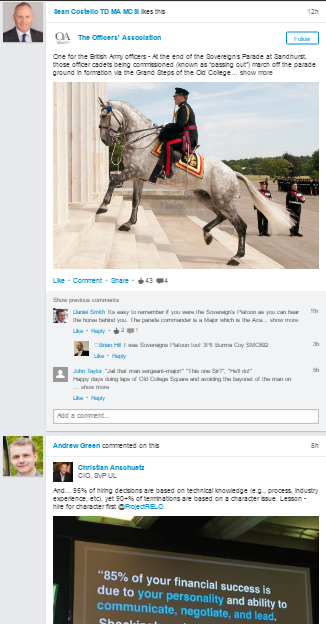3 amazing ways to generate B2B sales leads with social media
31 January 2017 By Northern Lights

Most business development sales teams now understand LinkedIn as a tool to connect with target clients – even if they are using it at a fairly basic level. But have they linked their sales campaign to your marketing and social media activities? Do you plan these together? Does your social media manager know who and how they should be engaging online?
Here I want to share the various ways that social media should be supporting your B2B business development. I know from experience of running courses that few sales teams understand, think about or engage with social media activities. Yet this could transform your business.
Before I look at social media, it is important to remember a fundamental principle about selling – research shows that it takes ‘seven touches to sell’ (do click on this – it’s a great blog about how to improve B2B sales leads and conversion). You typically need to be in touch with someone seven times before they buy. That could be a first meeting at a networking event, connecting on LinkedIn, a coffee, invitation to an event, sending an article with ‘I saw this and thought of you’ …… and that is where most people give up. At the fifth or sixth ‘touch’. Yet you have to keep going to convert a contact to business. I should say some say it is typically 13 touches that you need.
I know that for many professionals – and I include myself in this – there is a sense of not wanting to ‘bother’ people. To stay in touch 13 times can feel pushy. And this is where social media comes into its own. Good quality social media can do your networking and ‘touches’ in a subtle way – some even while you sleep!
Here I look at the three key ways to do this!
1. Relationship building
Too often people look at social media as cheap advertising – putting streams of information out, yet never stopping to create relationships in the process.
The three best B2B relationship tools in social media are LinkedIn, of course, Twitter and blogs.
Have you got a target list for the year? Start by researching who you know in these companies and connect with them. Then regularly check your timeline on LinkedIn (once a day, maybe once a week?). Look for comments and posts from or about them and get involved. To find your timeline, click on the Home button at the top of your LinkedIn profile and you will see all the activities of people in your network – it should look like this.
This timeline offers numerous opportunities to network and build relationships. It could be as basic as spotting a work notification saying ‘John Smith is celebrating ten years at xyz company’ and commenting in a relationship way. Don’t just press the ‘congratulations’ button – though that could be better than nothing – but add a comment that could start a conversation, perhaps ‘Extraordinary to think what has changed in those ten years, John. Don’t think I had even heard of LinkedIn then!’ or ‘Interesting to see how your role has changed, John. I’m looking at how tech has evolved at work in the last decade – would love your insights on this. Shall we have a coffee?’
Look what your contacts are sharing online and add your own comments, like and share these. I just spotted an article by someone who could be useful to clients on European discussions re legislation on AI – should robots have a legal personality? We are doing a lot in this market – here’s an opportunity to demonstrate expertise and passion by adding to the discussions, sharing, tagging clients, links to client blogs on this subject and more.
You don’t need or want to do this for every post, but make it strategic around your expertise and engage with key contacts.
The same applies to Twitter. Look at your target list and search which individuals and companies are on Twitter. Build a Twitter list of these, which you could call ‘target clients’ and keep it locked for privacy. That way you can go to your list each day and see what your targets are posting and get involved – comment, share, thank.
That is the reactive engagement. Also think about proactive. I often share articles with two or three people who I know would be interested in the subject. Or occasionally make Twitter ‘introductions’ if I think someone could help with a request or they could help each other. The usual networking activities, but online.
With all of this engagement, you have to be thoughtful and subtle as you would with traditional networking. You wouldn’t send a contact an email a day, and you probably wouldn’t do a chatty tweet to a target every day. I remember a few years ago, a contact of mine had been on a LinkedIn course and every morning she endorsed me on LinkedIn for a different skill. I came to dread opening my laptop as I felt stalked by her. One endorsement would have been a reasonable ‘touch’ – two or more felt pushy and irrelevant.
Blogs
I suspect it will surprise many people that writing blogs should be part of your relationship building. The key ways to do this are
- Listen to the questions your clients are asking and write blogs to help them. It will improve intimacy with your clients and help you to focus your services
- Invite key contacts and clients to write guest blogs for you – it is a recognition of their expertise and a compliment to others
- If you are writing blogs to help your clients, they will be of interest to many others – you can use them to follow up on sales calls, networking events. If your blogs are engaging, this is far better than a straight follow up email and should really add value to the relationship
2. Thought leadership
Years ago, we got someone in to deliver sales training for our team. At the time we did very little marketing other than networking and tenders. With the recession that had to change.
There was one thing about that session that really struck home. Nick, the trainer, asked us ‘are you doing the same things as you were a year ago?’. No. ‘And do your clients know what you are doing differently?’. No, probably not. At the time, he was persuading us to do enewsletters – which I had worried would irritate our clients. We had to go through a real mind-switch on the whole process!
Enewsletters are fine, but the thing that really demonstrates your expertise and how you are developing and changing services, are blogs.
Too many people think blogs are salesy – telling the world about what you do. Instead they should be using your expertise to help your clients. In the process you demonstrate your experience, knowledge and use examples that shows you work in this space – but if you write to be helpful first then the blog becomes engaging in a way that no newsletter or case study can ever achieve.
I have written about this a lot – in particular, how good social media makes you listen to and think about client problems and then how you can help them. I am writing this blog because so many clients struggle with how social media links to sales. I have in my head three or four people I want to help with this blog. I will use it when I next meet someone at, say, a networking event and want to follow up on a conversation. And I am thinking about turning this into an ebook. I know it will help a lot of people and I will then be more than happy to email, tweet, post on LinkedIn about it.
And that will become a ‘touch’ with my network of several thousand people.
I recently wrote a blog on the questions that boards should be asking about their social media. I was delighted to see a comment from a contact on the lines of ‘another really useful blog, timely for a board meeting’.
I haven’t seen this person in a long, long time. But this is a perfect example of someone reading your content and remembering it – we have essentially been networking while I was asleep. And without even realising it!
3. Articulating your sales pitch
One of the things I have found the most surprising is how blogging helps clients to marshall their thoughts. We often interview our clients and help them to write and structure a blog. And after a few months I ask what they are getting out of the process. Time and again they say, ‘it is helping me to articulate my thinking – and that is helping me to sell better. I am getting more business from better conversations.’
I did not expect this, but it is true. Often I struggle to explain something to a client and the process of blogging clarifies your thinking, you have to answer questions on the who, what, why of it all. And that helps with your sales conversations.
So that’s it. Three ways that social media can help you to generate B2B sales leads. Are your sales teams and digital teams working together – you could be amazed at what happens when they do?!



